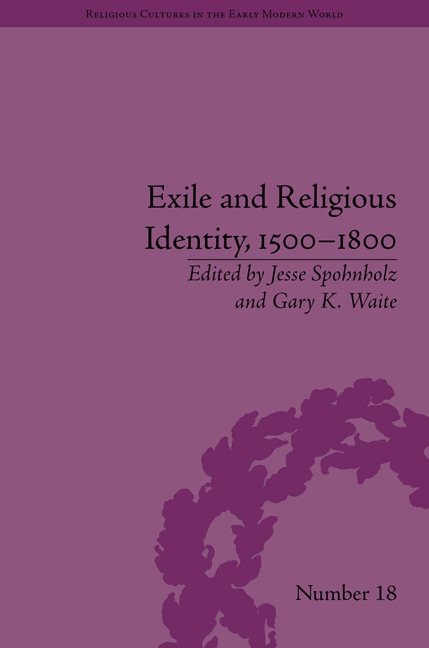Book contents
- Frontmatter
- CONTENTS
- Acknowledgements
- List of Contributors
- List of Figures and Tables
- Introduction
- Part I The Experience of Exile and the Consolidation of Religious Identities
- 1 ‘Count Every Step in my Flight’: Rhegius's and Luther's Consolations for Evangelical Exiles, 1531–3
- 2 Saints beyond Borders: Relics and the Expatriate English Catholic Community
- 3 Religious and Family Identity in Exile: Anne Percy, Countess of Northumberland in the Low Countries
- 4 The Reformed of Orange: Community Identity and Exile
- Part II The Experience of Exile and the Destabilization of Religious Identities
- Part III The Memory of Exile
- Notes
- Index
4 - The Reformed of Orange: Community Identity and Exile
from Part I - The Experience of Exile and the Consolidation of Religious Identities
- Frontmatter
- CONTENTS
- Acknowledgements
- List of Contributors
- List of Figures and Tables
- Introduction
- Part I The Experience of Exile and the Consolidation of Religious Identities
- 1 ‘Count Every Step in my Flight’: Rhegius's and Luther's Consolations for Evangelical Exiles, 1531–3
- 2 Saints beyond Borders: Relics and the Expatriate English Catholic Community
- 3 Religious and Family Identity in Exile: Anne Percy, Countess of Northumberland in the Low Countries
- 4 The Reformed of Orange: Community Identity and Exile
- Part II The Experience of Exile and the Destabilization of Religious Identities
- Part III The Memory of Exile
- Notes
- Index
Summary
On 19 March 1702 William III, the king of England, also the prince of the Provençal territory of Orange, died without an heir. His death triggered a new interest in the principality of Orange by its powerful neighbour, Louis XIV. The following year the king of France imposed a cruel choice on the Reformed of Orange: either convert and stay in Orange or remain Protestant but leave in exile. The latter was chosen by roughly 1,600 inhabitants. In June there was a veritable exodus towards Geneva under dramatic circumstances. By spring 1704 the generous Swiss hospitality had reached its limits and the religious refugees needed to find a new place of welcome: they reached Brandenburg, belonging to the Prussian king, after a second long trip in Europe.
The exile provoked a very real trauma among the Orangeois. The fact that they shared the same Calvinist faith as the Prussian sovereign provided an opportunity for adaptation to the northern land. After the loss of their homeland, the survival of the group was assured by the creation of the House of Orange, a charitable institution for the new arrivals on Prussian soil. But though this protective structure could help support their integration, it was also susceptible to facilitating exclusion. These exiles formed a new diaspora in the Prussian kingdom, which had already welcomed 20,000 other refugees from all over Europe.
- Type
- Chapter
- Information
- Exile and Religious Identity, 1500–1800 , pp. 51 - 66Publisher: Pickering & ChattoFirst published in: 2014

